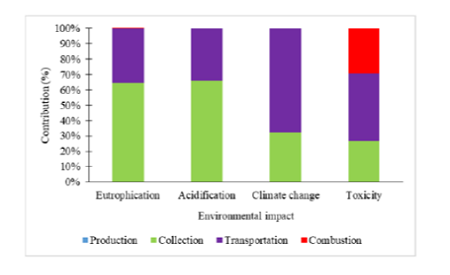


Indian Journal of Science and Technology
DOI: 10.17485/IJST/v15i19.1679
Year: 2022, Volume: 15, Issue: 19, Pages: 914-922
Original Article
Bi Tra Désiré Zinla1, Blaise Kamenan Koua2*, Prosper Gbaha1, Paul Magloire Ekoun Koffi1
1Laboratoire des Procédés Industriels, de Synthèse, de l’Environnement et des Energies Nouvelles, Institut National Polytechnique Félix Houphouët Boigny, B.P. 581, Yamoussoukro, Côte d’Ivoire
2Laboratoire des Sciences de la Matière, de l’Environnement et de l’Energie Solaire, UFR SSMT, Université Félix Houphouët Boigny, 22 B.P. 582 Abidjan 22, Côte d’Ivoire
*Corresponding Author
Email: [email protected]
Received Date:09 September 2021, Accepted Date:30 March 2022, Published Date:25 May 2022
Objectives: This study assesses the environmental performance of cocoa pod husk as a fuel for a biomass power plant in Côte d’Ivoire. Methods: In this study, a life cycle assessment (LCA) is applied to identify four environmental impacts generated during the production of electrical energy. LCA assesses the environmental impact on the global warming potential of electricity production from a biomass power plant using a cocoa pod husk in Côte d’Ivoire. The greenhouse gas emissions of this electricity production are compared with those of other energy sources. Findings: The results show that the production of one kilowatt-hour results in the emission of 1.12 g SO2eq,0.28 g PO4eq., 9.91 g 1.4 DBeq. and 328.22 g CO2eq. These emissions involve acidification, eutrophication, human toxicity and global warming respectively. The sensitivity analysis showed that the transport distance has an effect on the greenhouse gas (GHG) emissions of the chain. The sensitivity analysis showed that the transport distance has an effect on the GHG emissions of the sector. Thus, GHG emissions increase with the distance travelled by the transport vehicle. The analysis identified power plant locations that would reduce GHG emissions for the production of 1 kWh of electricity. Novelty: The life cycle assessment was used to evaluate the environmental impact of various processes using crop residues for energy purposes.
Keywords: Bioenergy; Crop residues; Cocoa pod husk; LCA; Thermal power plant
© 2022 Zinla et al. This is an open-access article distributed under the terms of the Creative Commons Attribution License, which permits unrestricted use, distribution, and reproduction in any medium, provided the original author and source are credited.
Published By Indian Society for Education and Environment (iSee)
Subscribe now for latest articles and news.